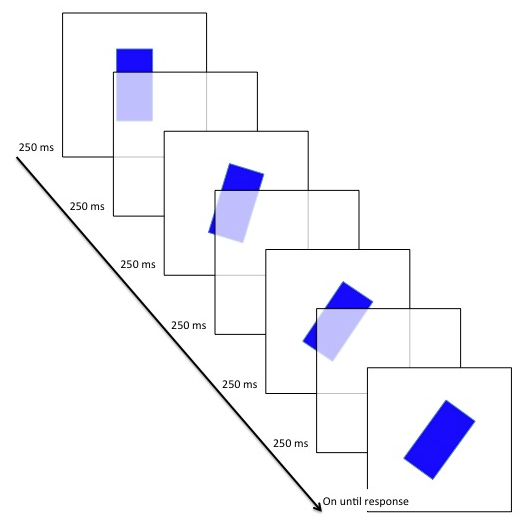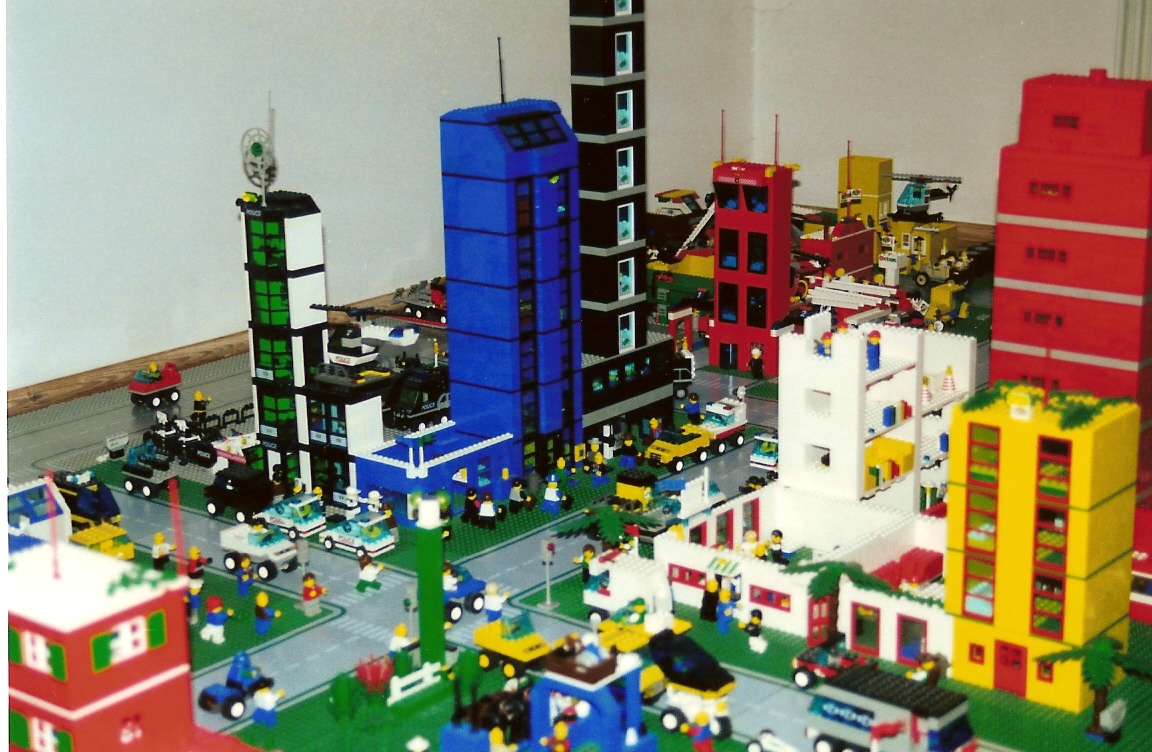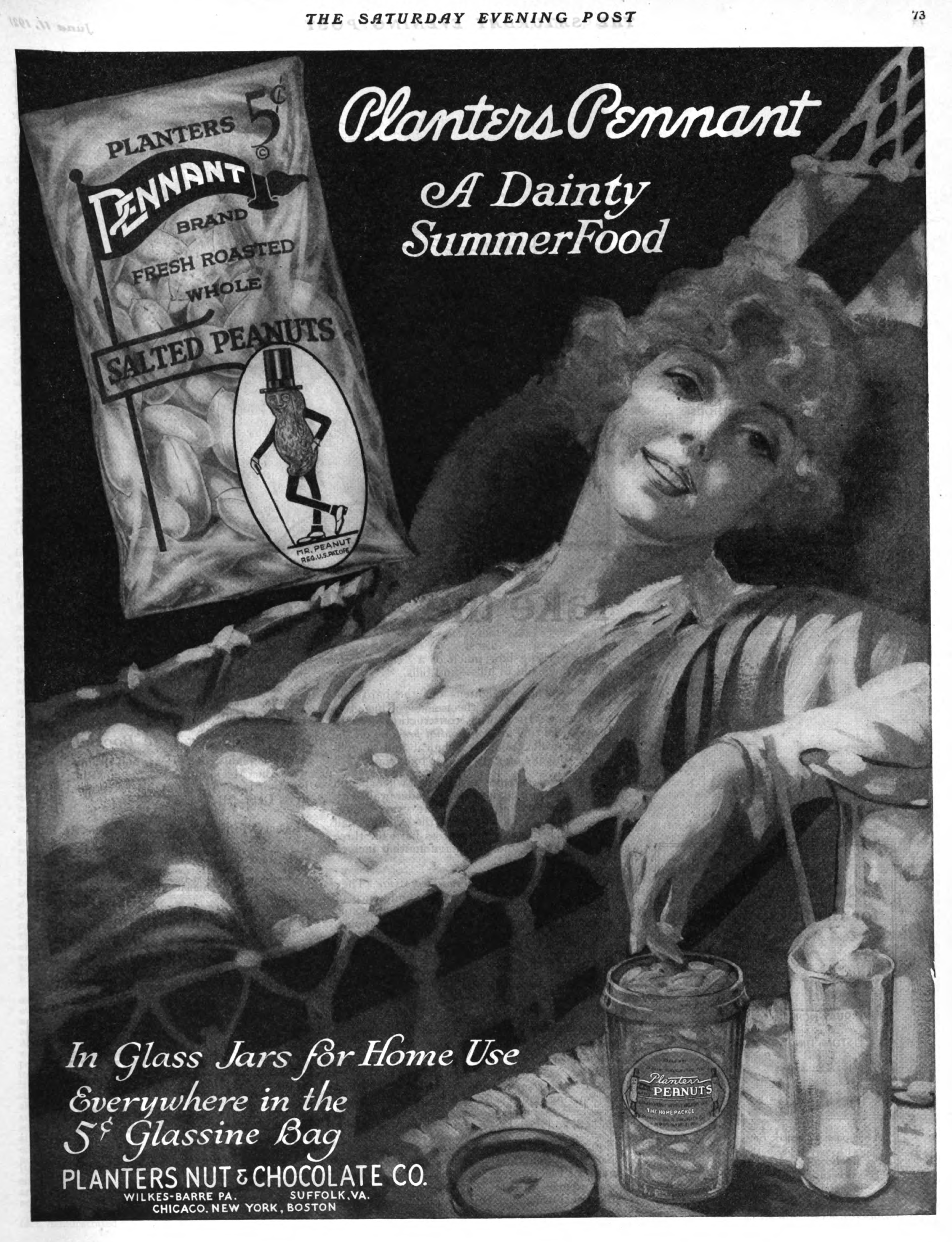|
Representational Momentum
Representational momentum is a small, but reliable, error in our visual perception of moving objects. Representational moment was discovered and named by Jennifer Freyd and Ronald Finke. Instead of knowing the exact location of a moving object, viewers actually think it is a bit further along its trajectory as time goes forward. For example, people viewing an object moving from left to right that suddenly disappears will report they saw it a bit further to the right than where it actually vanished. While not a big error, it has been found in a variety of different events ranging from simple rotations to camera movement through a scene. The name "representational momentum" initially reflected the idea that the forward displacement was the result of the perceptual system having internalized, or evolved to include, basic principles of Newtonian physics Classical mechanics is a physical theory describing the motion of macroscopic objects, from projectiles to parts of machinery, ... [...More Info...] [...Related Items...] OR: [Wikipedia] [Google] [Baidu] |
Visual Perception
Visual perception is the ability to interpret the surrounding environment through photopic vision (daytime vision), color vision, scotopic vision (night vision), and mesopic vision (twilight vision), using light in the visible spectrum reflected by objects in the environment. This is different from visual acuity, which refers to how clearly a person sees (for example "20/20 vision"). A person can have problems with visual perceptual processing even if they have 20/20 vision. The resulting perception is also known as vision, sight, or eyesight (adjectives ''visual'', ''optical'', and ''ocular'', respectively). The various physiological components involved in vision are referred to collectively as the visual system, and are the focus of much research in linguistics, psychology, cognitive science, neuroscience, and molecular biology, collectively referred to as vision science. Visual system In humans and a number of other mammals, light enters the eye through the cornea and is ... [...More Info...] [...Related Items...] OR: [Wikipedia] [Google] [Baidu] |
Jennifer Freyd
Jennifer Joy Freyd (; born October 16, 1957, in Providence, Rhode Island) is an American researcher, author, educator, and speaker. Freyd is an extensively published scholar who is best known for her theories of betrayal trauma, DARVO, institutional betrayal, and institutional courage. Freyd is the Founder and President of the Center for Institutional Courage, Professor Emerit of Psychology at the University of Oregon, Adjunct Professor of Psychiatry and Behavioral Sciences in the School of Medicine, Faculty Fellow at the Clayman Institute for Gender Research, Affiliated Faculty, Women's Leadership Lab, Stanford University and principal investigator of the Freyd Dynamics Lab. Freyd is a Member of the Advisory Committee, 2019–2023, for the Action Collaborative on Preventing Sexual Harassment in Higher Education, National Academies of Science, Engineering, and Medicine. She is a Fellow of the American Psychological Association, the American Psychological Society, and the Amer ... [...More Info...] [...Related Items...] OR: [Wikipedia] [Google] [Baidu] |
Classical Mechanics
Classical mechanics is a physical theory describing the motion of macroscopic objects, from projectiles to parts of machinery, and astronomical objects, such as spacecraft, planets, stars, and galaxies. For objects governed by classical mechanics, if the present state is known, it is possible to predict how it will move in the future (determinism), and how it has moved in the past (reversibility). The earliest development of classical mechanics is often referred to as Newtonian mechanics. It consists of the physical concepts based on foundational works of Sir Isaac Newton, and the mathematical methods invented by Gottfried Wilhelm Leibniz, Joseph-Louis Lagrange, Leonhard Euler, and other contemporaries, in the 17th century to describe the motion of bodies under the influence of a system of forces. Later, more abstract methods were developed, leading to the reformulations of classical mechanics known as Lagrangian mechanics and Hamiltonian mechanics. These advances, ma ... [...More Info...] [...Related Items...] OR: [Wikipedia] [Google] [Baidu] |
Cognitive Psychology
Cognitive psychology is the scientific study of mental processes such as attention, language use, memory, perception, problem solving, creativity, and reasoning. Cognitive psychology originated in the 1960s in a break from behaviorism, which held from the 1920s to 1950s that unobservable mental processes were outside the realm of empirical science. This break came as researchers in linguistics and cybernetics, as well as applied psychology, used models of mental processing to explain human behavior. Work derived from cognitive psychology was integrated into other branches of psychology and various other modern disciplines like cognitive science, linguistics, and economics. The domain of cognitive psychology overlaps with that of cognitive science, which takes a more interdisciplinary approach and includes studies of non-human subjects and artificial intelligence. History Philosophically, ruminations on the human mind and its processes have been around since the times of the a ... [...More Info...] [...Related Items...] OR: [Wikipedia] [Google] [Baidu] |
Top-down And Bottom-up Design
Top-down and bottom-up are both strategies of information processing and knowledge ordering, used in a variety of fields including software, humanistic and scientific theories (see systemics), and management and organization. In practice, they can be seen as a style of thinking, teaching, or leadership. A top-down approach (also known as ''stepwise design'' and stepwise refinement and in some cases used as a synonym of ''decomposition'') is essentially the breaking down of a system to gain insight into its compositional sub-systems in a reverse engineering fashion. In a top-down approach an overview of the system is formulated, specifying, but not detailing, any first-level subsystems. Each subsystem is then refined in yet greater detail, sometimes in many additional subsystem levels, until the entire specification is reduced to base elements. A top-down model is often specified with the assistance of "black boxes", which makes it easier to manipulate. However, black boxes may fa ... [...More Info...] [...Related Items...] OR: [Wikipedia] [Google] [Baidu] |
Phi Phenomenon
The term phi phenomenon is used in a narrow sense for an apparent motion that is observed if two nearby optical stimuli are presented in alternation with a relatively high frequency. In contrast to beta movement, seen at lower frequencies, the stimuli themselves do not appear to move. Instead, a diffuse, amorphous shadowlike something seems to jump in front of the stimuli and occlude them temporarily. This shadow seems to have nearly the color of the background. Max Wertheimer first described this form of apparent movement in his habilitation thesis, published 1912, marking the birth of Gestalt psychology. In a broader sense, particularly if the plural form ''phi phenomena'' is used, it applies also to all apparent movements that can be seen if two nearby optical stimuli are presented in alternation. This includes especially beta movement, which has been regarded as the illusion of motion in cinema and animation, although it can be argued that beta movement indicates long-range ... [...More Info...] [...Related Items...] OR: [Wikipedia] [Google] [Baidu] |
Rotating Cube +4 Probe
Rotation, or spin, is the circular movement of an object around a '' central axis''. A two-dimensional rotating object has only one possible central axis and can rotate in either a clockwise or counterclockwise direction. A three-dimensional object has an infinite number of possible central axes and rotational directions. If the rotation axis passes internally through the body's own center of mass, then the body is said to be ''autorotating'' or ''spinning'', and the surface intersection of the axis can be called a ''pole''. A rotation around a completely external axis, e.g. the planet Earth around the Sun, is called ''revolving'' or ''orbiting'', typically when it is produced by gravity, and the ends of the rotation axis can be called the ''orbital poles''. Mathematics Mathematically, a rotation is a rigid body movement which, unlike a translation, keeps a point fixed. This definition applies to rotations within both two and three dimensions (in a plane and in space, r ... [...More Info...] [...Related Items...] OR: [Wikipedia] [Google] [Baidu] |
Bench Out 0
Bench or The Bench can refer to: Furniture *Bench (furniture), a long seat *Workbench, a table at which manual work is done *Countertop or benchtop Arts * ''The Bench'' (2000 film), a Danish film * ''The Bench'' (TV series), a 2001 British series * ''The Bench'' (Hogarth), a painting by William Hogarth * ''The Bench'' (book), a 2021 children's book by Meghan, Duchess of Sussex Business * Bench (British clothing brand) *Bench (Philippine clothing brand) *Bench Accounting, a company Geology *Bench (geology), a long, relatively narrow strip of relatively level or gently inclined land of differing origins that is bounded by distinctly steeper slopes above and below it *Benches, steps cut into the side of open-pit mines Law and politics *Bench (law), the location where a judge sits while in court, often a raised desk in a courtroom; also refers to the judiciary as a whole, and to a group of judges hearing a case and judging on a case **Bench, the panel or body of justices of the pea ... [...More Info...] [...Related Items...] OR: [Wikipedia] [Google] [Baidu] |
Planters
Planters Nut & Chocolate Company is an American snack food company now owned by Hormel Foods. Planters is best known for its processed nuts and for the Mr. Peanut icon that symbolizes them. Mr. Peanut was created by grade schooler Antonio Gentile for a 1916 contest to design the company's brand icon. The design was modified by a commercial artist and has continued to change over the years. History Planters was founded by Italian immigrant Amedeo Obici in Wilkes-Barre, Pennsylvania. He started his career as a bellhop and fruit stand vendor in Scranton, Pennsylvania. Obici later moved to Wilkes-Barre, opened his own fruit stand, and invested in a peanut roaster. Obici turned peddler within a few years, using a horse and wagon, and calling himself "The Peanut Specialist". In 1906, Obici entered a partnership with Mario Peruzzi, the soon to be owner of Planters. Peruzzi had developed his own method of blanching whole roasted peanuts, doing away with the troublesome hulls and skin ... [...More Info...] [...Related Items...] OR: [Wikipedia] [Google] [Baidu] |
Cognition
Cognition refers to "the mental action or process of acquiring knowledge and understanding through thought, experience, and the senses". It encompasses all aspects of intellectual functions and processes such as: perception, attention, thought, intelligence, the formation of knowledge, memory and working memory, judgment and evaluation, reasoning and computation, problem solving and decision making, comprehension and production of language. Imagination is also a cognitive process, it is considered as such because it involves thinking about possibilities. Cognitive processes use existing knowledge and discover new knowledge. Cognitive processes are analyzed from different perspectives within different contexts, notably in the fields of linguistics, musicology, anesthesia, neuroscience, psychiatry, psychology, education, philosophy, anthropology, biology, systemics, logic, and computer science. These and other approaches to the analysis of cognition (such as embodied cognition) ... [...More Info...] [...Related Items...] OR: [Wikipedia] [Google] [Baidu] |
Visual Perception
Visual perception is the ability to interpret the surrounding environment through photopic vision (daytime vision), color vision, scotopic vision (night vision), and mesopic vision (twilight vision), using light in the visible spectrum reflected by objects in the environment. This is different from visual acuity, which refers to how clearly a person sees (for example "20/20 vision"). A person can have problems with visual perceptual processing even if they have 20/20 vision. The resulting perception is also known as vision, sight, or eyesight (adjectives ''visual'', ''optical'', and ''ocular'', respectively). The various physiological components involved in vision are referred to collectively as the visual system, and are the focus of much research in linguistics, psychology, cognitive science, neuroscience, and molecular biology, collectively referred to as vision science. Visual system In humans and a number of other mammals, light enters the eye through the cornea and is ... [...More Info...] [...Related Items...] OR: [Wikipedia] [Google] [Baidu] |







